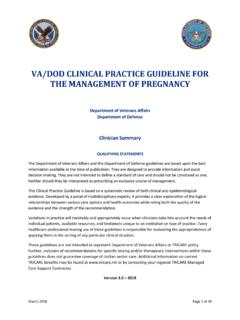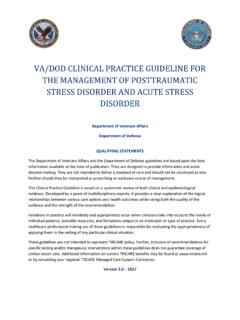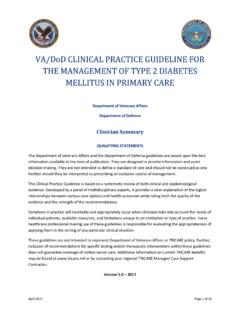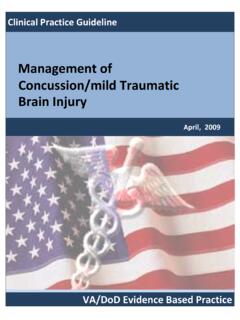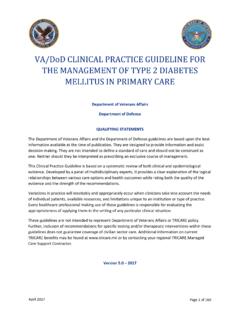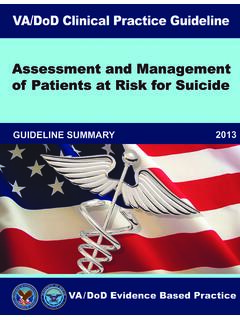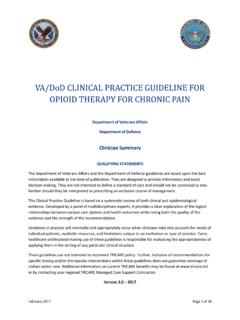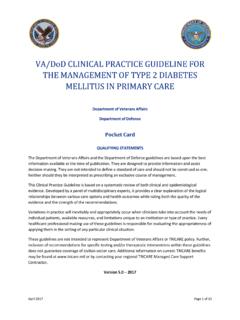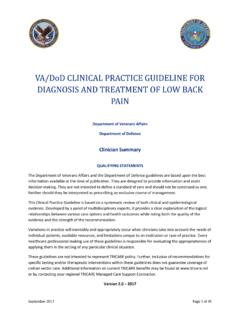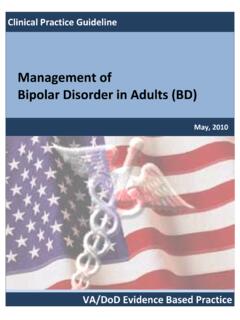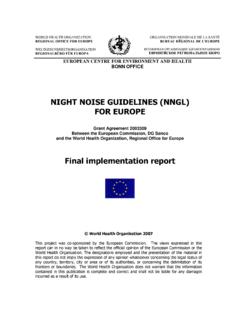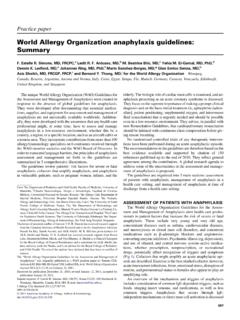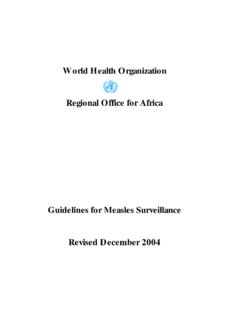Transcription of Management of Concussion/mild Traumatic Brain …
1 Clinical Practice Guideline Management of Concussion/mild Traumatic Brain Injury April, 2009 VA/DoD Evidence Based Practice VA/DoD CLINICAL PRACTICE GUIDELINE FOR Management OF Concussion/mild Traumatic Brain INJURY (mTBI) Department of Veterans Affairs Department of Defense QUALIFYING STATEMENTS The Department of Veterans Affairs (VA) and The Department of Defense (DoD) guidelines are based on the best information available at the time of publication. They are designed to provide information and assist in decision-making. They are not intended to define a standard of care and should not be construed as one.
2 In addition, they should not be interpreted as prescribing an exclusive course of Management . Variations in practice will inevitably and appropriately occur when providers take into account the needs of individual patients, available resources, and limitations unique to an institution or type of practice. Every healthcare professional making use of these guidelines is responsible for evaluating the appropriateness of applying them in the setting of any particular clinical situation. Version 2009 VA/DoD Clinical Practice Guideline For Management of concussion /mTBI Prepared by: The Management of concussion /mTBI Working Group With support from.
3 The Office of Quality and Performance, VA, Washington, DC & Quality Management Directorate, United States Army MEDCOM VA/DoD Clinical Practice Guideline For Management of concussion /mTBI Introduction The Clinical Practice Guideline for the Management of Concussion/mild Traumatic Brain Injury (mTBI) was developed under the auspices of the Veterans health Administration (VHA) and the Department of Defense (DoD) pursuant to directives from the Department of Veterans Affairs (VA). VHA and DoD define clinical practice guidelines as: Recommendations for the performance or exclusion of specific procedures or services derived through a rigorous methodological approach that includes: Determination of appropriate criteria such as effectiveness, efficacy, population benefit, or patient satisfaction; and Literature review to determine the strength of the evidence in relation to these criteria.
4 The intent of these guidelines is to: Reduce current practice variation and provide facilities with a structured framework to help improve patient outcomes Provide evidence-based recommendations to assist providers and their patients in the decision-making process related to the patient health care problems Identify outcome measures to support the development of practice-based evidence that can ultimately be used to improve clinical guidelines . Background The Centers for Disease Control and Prevention (CDC) has estimated that each year, approximately million Americans survive a Traumatic Brain injury (TBI), among whom approximately 230,000 are hospitalized.
5 Approximately 50,000 Americans die each year following Traumatic Brain injury, representing one third of all injury-related deaths. The leading causes of TBI are falls (28%), motor vehicle-traffic accidents (20%), struck by/against events (19%) and assaults (11%). It is estimated that of the total reported TBIs, the vast majority (75%-90%) of these fit the categorization of mild-TBI and that approximately ninety percent ( 90%) of these follow a predictable course and experience few, if any, ongoing symptoms and do not require any special medical treatment.
6 More than million patients with mTBI are treated and released from an emergency department each year. Only a small sub-set of these patients (10%) experience post-injury symptoms of a long lasting nature. The incidence of TBI has significantly increased in the patient population of the DoD and VHA as a result of injuries during recent military and combat operations. In the past 8 years, TBI has emerged as a common form of injury in service men and women serving in Operation Enduring Freedom (OEF) and Operation Iraqi Freedom (OIF).
7 Although penetrating TBI is typically identified and cared for immediately, mTBI may be missed, particularly in the presence of other more obvious injuries. Due to numerous deployments and the nature of enemy tactics, troops are at risk for sustaining more than one mild Brain injury or concussion in a short timeframe. As experience with this condition in OEF and OIF service persons and veterans accumulated, it became clear that screening for possible TBI in OEF and OIF veterans could contribute to ensuring that patients are identified and treatment implemented.
8 In response to this need, VHA established a task force including members with expertise in Physical Medicine and Rehabilitation, Neurology, Psychiatry, Psychology, Primary Care, Prevention, and Medical Informatics to develop a screening tool and evaluation protocol. Although TBI is a significant public health problem, currently there are no validated screening instruments specific to TBI that are accepted for use in clinical practice. Therefore, the task force reviewed existing literature on screening for TBI, examined the efforts of individual military Medical Treatment Facilities (MTF s) and Department of Veterans Affairs (VA) Medical Centers that had implemented TBI screening locally, consulted with the Defense and Veterans Brain Injury Center Introduction Page 1 VA/DoD Clinical Practice Guideline For Management of concussion /mTBI (DVBIC), and considered data on the natural history of TBI.
9 Based on these efforts, the task force developed a consensus document that included definitions, classification and taxonomy. Following the development of a definition document, the task force constructed a screening instrument to assist in identifying OEF and OIF veterans who may be suffering from TBI, and a protocol for further evaluation and treatment of those whose screening tests are positive. Furthermore, a national electronic clinical reminder, VA-TBI Screening, was built incorporating this screening instrument. These protocols have been considered the seed for the development of this Evidence Based Practice Guideline.
10 The DoD has published Clinical Guidance for Management of Mild-TBI in Theater and mTBI in Non-Deployed Medical Activities. After the VA/DoD Working Group completed the review of the evidence for this guideline an Institute of Medicine (IOM) report addressing long-term consequences of Traumatic Brain Injury was published (IOM, 2009). The IOM committee concluded, on the basis of its evaluation, that there is limited/suggestive evidence of an association between sustaining a mild TBI resulting in loss of consciousness or amnesia and the development of unprovoked seizures, ocular and visual motor deterioration.
